.png.transform/rendition-xs/image_image%20(1).png)
Ribeira Sacra, The Heroic Wine Region
This report is a copy of an article originally published on the Estonian Sommelier Association’s website. Kristjan Markii, the director of that organization and a wine journalist, participated in a trip organized by ICEX and Wines from Spain to DO Ribeira Sacra.
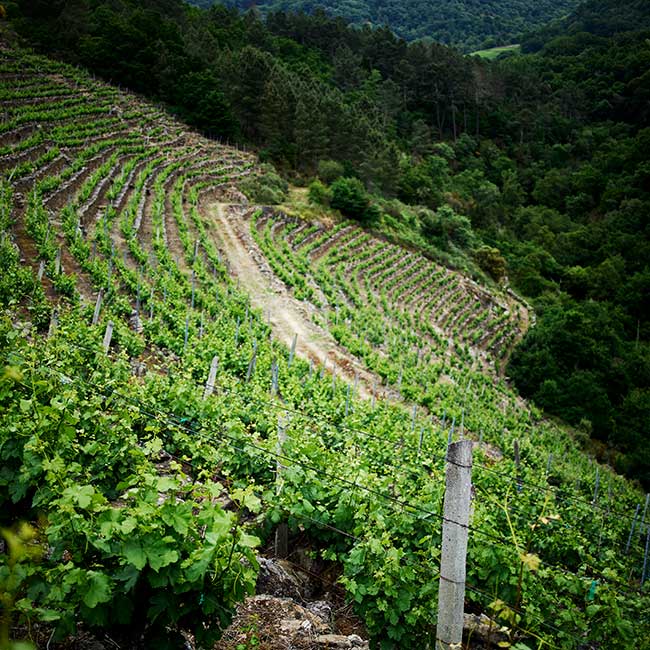
Original article published in Estonia
Heroic is the word that perhaps best describes this tiny, relatively unknown area in north-western Spain’s Galicia region, which is also known as Green Spain. Ribeira Sacra is one of the five renowned wine regions in Galicia, yet it has remained undeservingly in the shadow of the more famous Rías Baixas. I have visited and seen a lot of places where viticulture is extremely complex thanks to the steep slopes. For example, the Mosel-Saar-Ruwel in Germany or the Douro Valley in Portugal, however, these fade in comparison to Ribeira Sacra´s powerful views and dedication of the wine makers. Not that the regions mentioned are somehow worse, but the Ribeira Sacra is something new and undiscovered, a place that is unknown and spoken considerably less about.
Interestingly, the Ribeira Sacra takes its name from a faulty translation — first mentioned in chronicles in 1124 that refer to the Rovoyra Sacratale, which in turn alludes to the sacred oak forest. A new chronicle was written in 1608, and the author, Father Yepe, interpreted the name either deliberately or accidentally in his own way and named it Rivoyra Sacrata (holy rivers-riverbanks), translated into Spanish spelling as the Ribeira Sacra. Since there were very many sacred places on the rivers, no one protested the naming, and so the name has lasted. Today, in addition to quality wines, we also find a collection of the largest Romanesque architecture and art in Europe. One of the most difficult-to-reach attractions situated in between mountains, the Ribeira Sacra is hiding a breath-taking mix of fantastic nature, views, wine, gastronomy, history, and art.
There is no future without history
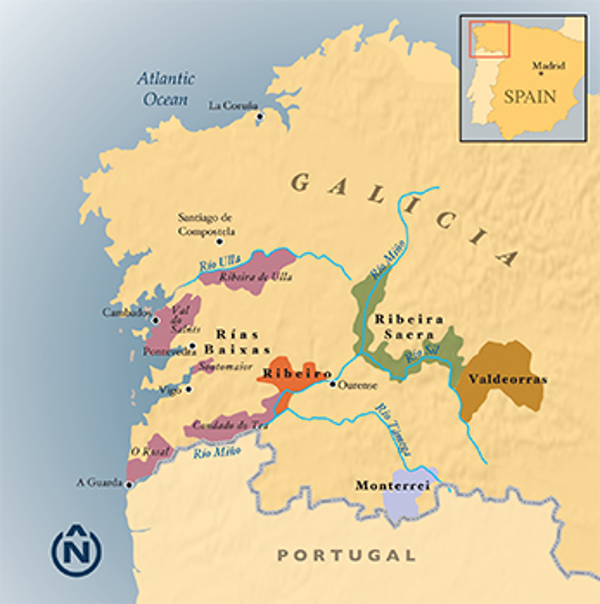
Vines have grown in Ribeira Sacra since the beginning of time, and the wine trade was started by Phoenicians and Carthaginians. Viticulture got a big push from Romans who arrived in search of gold. As usual, they were accompanied by thirst and the need for wine and that had to be satisfied with local means or funds. However, the foundations to the numerous terraces (which locals call socalcos), and modern winemaking, was established by the Benedictine and Cistercian order monks, who built plenty of churches and monasteries. This happened, because after the finding of the last resting place of Saint James, Santiago de Compostela became one of the most important destinations for pilgrimage besides Jerusalem and Rome. The wine was consumed by both locals and guests from far and wide.
Like many other European wine regions at the end of the 19th century, the Ribeira Sacra was hit hard by the spread of phylloxera. The crisis was amplified by the 20th century’s civil war (1936-1939) and the difficult economic situation. Many families left to find income in more distant countries and regions. It could be said that this was, in its own way, a Sleeping Beauty, which began to gradually wake up after Spain joined the European Union n 1986. Merging brought investments, and by the end of the 1980s, the people started to move back to the countryside, and began to make wine, at first predominantly for their own use. Permission for bottling and sale in the geographically indicated Vino de la Tierra category was obtained in 1993. The area acquired official Denominación de Origen status in 1996, which stimulated viticulture and trade.
What and where?
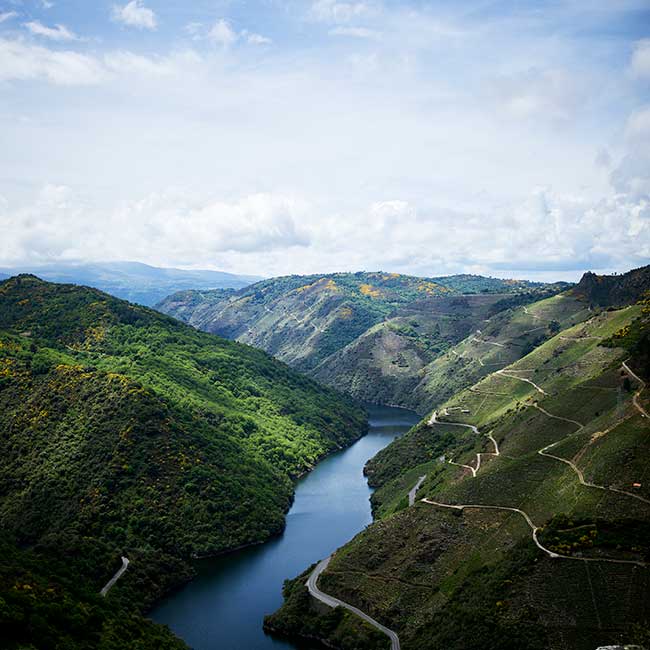
The Ribeira Sacra is located in the eastern part of Galicia, adjacent to the Valdeorras area, which is considered to be the gateway linking the region to the rest of Spain.
The Ribeira Sacra vineyards are planted on the steep slopes of the valleys and canyons of the rivers Sil and Miño and their tributaries. The rivers bring little relief to the hot summers and cold winters of the continental climate. On the other hand, the slopes are so steep that, at times, it seems impossible to grow grapes in such a place, and the sweat and the trouble that has gone into the establishment and administration of these vineyards is difficult to do. The steeper vineyards can be tilted at 85-degrees, and many can only be accessed along the waterways.
During the downturn in the 1980s the vineyards covered only a few hundred hectares, these had expanded to 900 hectares by 1996 when the DO classification was confirmed. Today, according to the rules of DO, out of the allowed 2,500 hectares, vineyards can be found on nearly 1,250 hectares. There are 2,353 growers and 93 sellers or bodegas. From these numbers, it can be concluded that the wine economy is similar to the model of the Champagne or Douro Valley, where many wine houses purchase their grapes from numerous growers.
There are five subregions within D.O. of the Ribeira Sacra, which are often named after the river on which they are located.
Amandi. 83.19 hectares of vineyards. It is located on the north shore of the river Sil and is considered a kind of Grand Cru, as the vineyards are facing south. This ensures sunshine throughout the day and is ideally suited for late ripening grapes. The area is highly valued throughout history – from the Romans to today's winemakers.
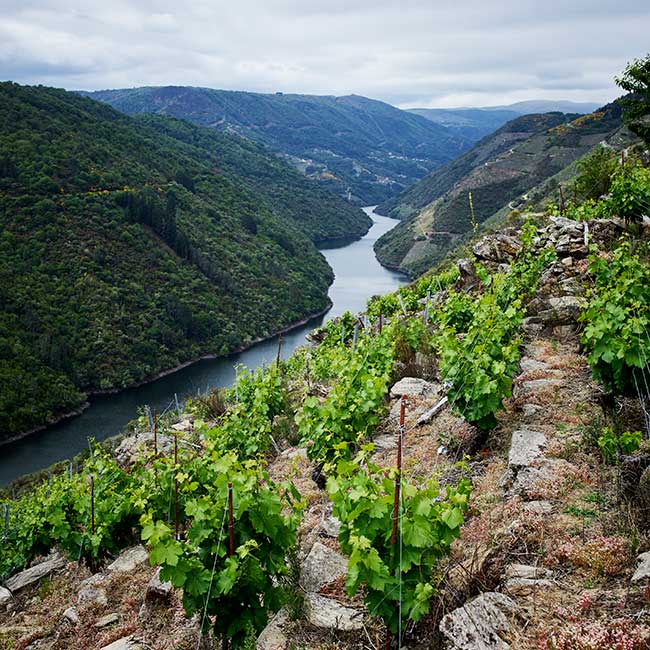
Chantada. 197.8 hectares of vineyards. The westernmost subregion on the west shore of the river Miño. Thanks to its location, the influences of the Atlantic Ocean are also felt, the temperatures are more homogeneous and it is considered to have one of the best growing conditions.
Quiroga-Bibei. 378.07 hectares of vineyards. The 40kilometre-long area on the banks and beyond of Sil and its tributary Bibei. The conditions here are already considered to be close to the Mediterranean climate, but the region is still sparsely populated. As the slopes are flatter here, it is possible to build larger vineyards, which can be managed with less effort and cost.
Ribeiras do Miño. 356.6 hectares of vineyards. As the name says, the area is located on the eastern slope of the Miño River. The vineyards are built almost exclusively on the granite surface along the river from the north to the south. Like the previous region, some slopes are gentler and have been used to build larger vineyards.Ribeira do Sil. 135.28 hectares of vineyards. An area on the southern shore of the river Sil, which even extends over the river Miño, and the vineyards are built in north-west direction. Today, in light of climate change, this subregion is gaining more attention. Several wineries have begun to acquire fields that are obscured by the sun.
The label of the wine bottle may indicate the name of the subregion, there are also more precise "village names", but the name of the single vineyard is not yet allowed on the label of the bottle.
Geological processes linked to tectonic plates have shaped the soil in the area. Predominantly found soils are granite and slate, along with their metamorphic rocks, and even some clay. The areas bordering the Miño River have more granite soil and the areas around River Sil are a mixture of granite and slate.
Grape varieties
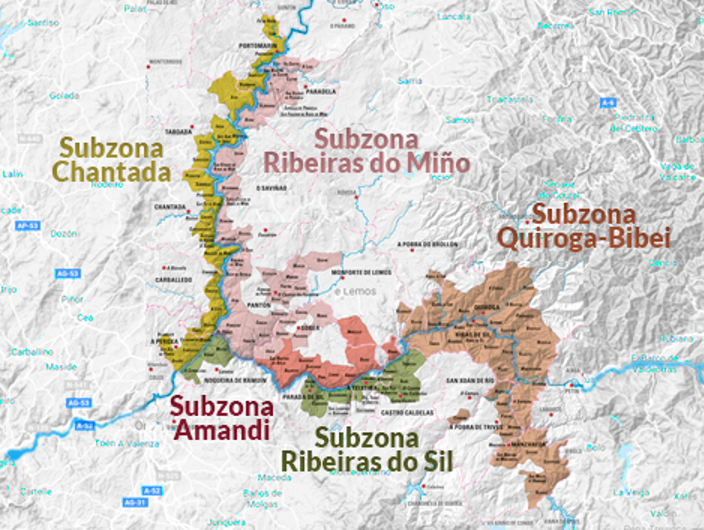
Grape varieties grown and used in Ribeira Sacra are very familiar to Galician wine fans, but they also find many surprises. Most growers are focused on the cultivation of a particular variety or varieties, but they also use the so-called field blends and increasingly are experimenting with forgotten varieties. There are indicative varieties, which are considered to be appropriate and authorised, and then there are the "complementary" varieties, which may be used in mixtures in smaller volumes. As there are quite a number of rebellious winemakers in the area, the restrictions don’t sit well with them, so the wines are made outside the DO regulations and the sales are in the categories of geographically marked wine or table wine.
The latest amendments of regulations were made by the Consejo Regular DO Ribeira Sacra in 2018, at the end of the year. To accommodate as many wine houses and wines as possible in the DO category, the recommended and authorized varieties and the additional terms allowed on the wine bottle label were added.
The most important grape is the Mencia, which makes elegant red wines, with good acidity, spicy and red berry flavours, which is enjoyable not only as a young wine, but is also suitable for aging in the cellar. In 2018, the total harvest of red grapes amounted to 5.7 million kilograms, of this, the Mencia accounted for 5.2 million kilograms.
The recommended varieties are: Merenzao, Brancellao, Sousón and three varieties of Caíños – Longo, Tinto and Bravo.
Authorised varieties, which are more commonly used in wines in smaller volumes, are Garnacha Tintorera (Alicante Bouschet), Mouratón, Tempranillo and Gran Negro.
The most important of the white varieties is Godello, which gives lush wines with honey and floral aromas with a structured acidity and minerality. The wines are made in different styles –from light and fresh, to creamy and lush, aged in oak, or on the lees.
The recommended varieties are: Albariño, Torrontés, Loureira, Treixadura, Dona Branca, Branco Lexítimo and Caíño Branco.
Regulations, regulations, regulations
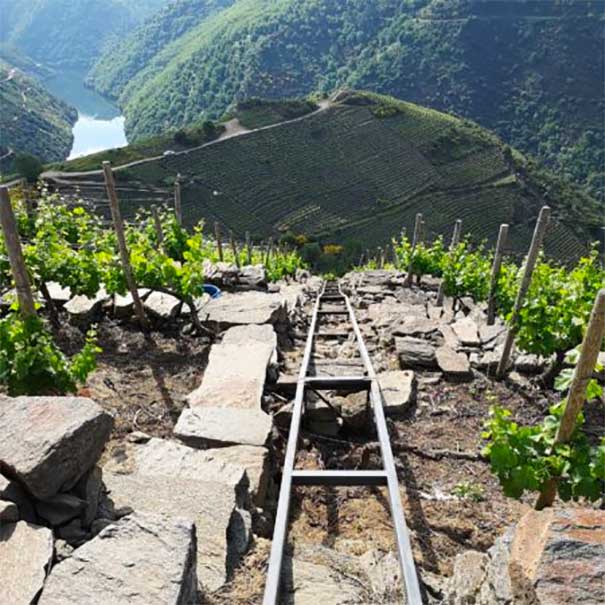
On the labels of wine bottles, we encounter the following titles and terms that help to understand what style and how the wines have been made. According to each style, a "quality seal" is printed in its own colour on the back of the wine bottle. In addition, the Ribeira Sacra wines bear a collective trademark - Viticulture Heroica, from CERVIM (Centro di Ricerche, Studi e Valorizzazione per la Viticoltura Montana) association, which unites wine regions and producers around the world in similar circumstances.
Tinto Ribeira Sacra – minimum alcohol content is 11%. This category of red wines contains at least 70% of the Mencia grape. If the content of Mencia grape is 85% or more, the grape variety may be presented on the label. Since the name of the grape is useful for marketing, most of the wines in that category use it. The back label has a printed quality seal with a bronze coloured background.
Tinto Ribeira Sacra Summum – Minimum alcohol content is 11%. The former regulation of at least 60% content of Mencia was abolished by 2018 in order to allow the winemakers to highlight other red varieties and blends. At least 85% of the recommended varieties must be used, and if at least 85% of one of the recommended grape varieties is contained, the name of the variety may be shown on the bottle label. The back label has a printed quality seal with a red coloured background.
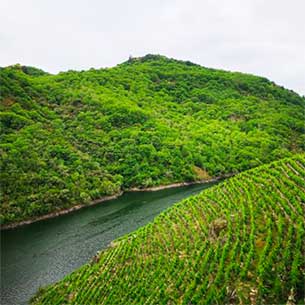
Blanco Ribeira Sacra Summum – Minimum alcohol content is 11%. A category for white wines requiring at least 85% of the recommended variety or varieties. If at least 85% of one of the recommended grape varieties has been used, the name of the variety may be shown on the bottle label. The back label has a printed quality seal with green coloured background
Rosado Ribeira Sacra Summum – Minimum alcohol content is 11%. As the rose wine is one of the rising trends for local wines, the possibility to produce rose wine was made available in 2018 under the DO regulations. Must use at least 85% of the recommended varieties and, if at least 85% of one of the recommended grape varieties has been used, the name of the variety may be shown on the bottle label. The back label has a printed quality seal with a red coloured background.
Barrica – An additional term for white and red Summum and Tinto Ribeira Sacra wines that have matured in oak barrels. For all, the requirement a minimum of 12% alcohol. For white wines, the requirement is at least three months in oak barrels with a maximum size of 600l. For red wines, at least six months in oak barrels with a maximum size of 500 l.
Guarda – Additional term, confirmed in the end of 2018. The aim was catch up with the times, and to highlight the wines that have matured in larger barrels or made of other materials (concrete, stainless, etc.). Applies only to white and red Summum and Tinto Ribeira Sacra categories of wines. In the case of white wines, the requirement shall be at least four months maturing in a wooden barrel with a maximum volume of 8000l or some other container with a maximum size of 5000 l. In the case of red wines, an aging of at least six months in wooden barrels with a maximum size of 10 000 l, or other containers with a maximum capacity of 5000 l. A minimum alcohol content of 12% is required.
Wineries
The following wine houses have received the most international attention: Bodegas Regina Viarum, Adega Algueira, Dominio Do Bibei, Don Bernardino, Finca Millara, Adega Cachín, Envínate, Bodegas y Viñedos Raúl Pérez, Guimaro. In addition, there are a myriad of small undiscovered talents, a longer list of wine houses is found under additional reading in the Ribeira Sacra Guide.
Various sub-regions, different heights of vineyards, soils, duration of sunshine, unique grape varieties and distinctive styles give the winemakers the opportunity to prepare an exciting, terroir-based wines. These wines are not cheap – given the volume, complexity and low yield of the work, the costs of wine making are high. According to one winemaker, the basic cost of restoring one hectare of a traditional vineyard is estimated to be a total of 80 000 to 100 000 euros consisting of terraces and railroads for transport. Even so, the prices of wines purchased locally in Spain begin at roughly EUR 12-15. The most expensive bottles are offered in the price range of 80 euros. At the same time, the wines are unique and exciting and offer a well-deserved mental and physical experience. It is because of this that they have found their way into trendy restaurants, wine shops and bars in North America, Europe, Scandinavia and Japan.
The study trip to Galicia, visiting the regions of Rias Baixas, Ribeiro and Ribeira Sacra, was made possible thanks to the support of the Ministry of Economic Affairs, Commerce and Tourism of Spain and the Commerce Department of the Spanish Embassy in Helsinki.
Text: Kristjan Markii

